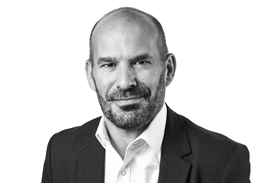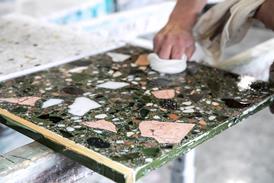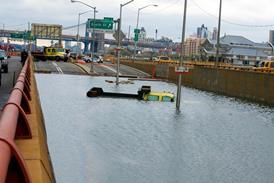Whether it involves negotiating with kidnappers, retrieving a Renoir or tracking down a lorry, Julian Radcliffe knows a good crime-fighting opportunity when he sees one. Twenty-five years ago, Radcliffe was fresh out of Oxford University working as an insurance broker at Hogg Robinson, when he saw that there was no obvious preventative or crisis management advice for company staff going abroad. In 1974, he founded Control Risks to provide this advice. Today, the company is one of the leading specialist protection providers, with more than 3,500 clients worldwide and an annual turnover of £20 million.
The 1990s have seen Radcliffe, now 50, launch two stolen property registers. In 1991 he founded the Art Loss Register, a central database used by the police, insurers and the art trade to register and recover stolen art. The Equipment Register (TER), set up in 1995, provides a similar service for the construction industry. The two registers, claims Radcliffe, have been successes both commercially and in fighting crime.
Prospects of recovery
TER, which has more than 300,000 items registered, helped police recover more than £1 million worth of construction site equipment last year. The Art Loss Register currently numbers more than 100,000 stolen items valued at around £3 billion, a third of which are registered by galleries, museums, commercial premises and public institutions.
While police have praised the Register, Radcliffe does admit the percentage chance of having something recovered is very small: “If you register something stolen with us, over ten years, you’ve got a 1% or 2% chance of getting it back, but that should improve as we get a bigger database and get more searches,” he asserts.
The statistics don’t reflect the amount of art theft prevented by the Register, he adds: “There was one case where the police came into our office, told us that a painting was going to be stolen later that day and asked us where the painting was,” he recalls. “Using our network of galleries, dealers and auction houses, we worked out where it was and the police made some arrests.”
Radcliffe long ago relinquished management of Control Risks and while still chairman of TER, now dedicates virtually all his working hours to developing the Art Loss Register. Based at the Register’s suitably grand head office in Grosvenor Place, London, much of Radcliffe’s work involves flying visits abroad in a bid to widen the net — he’s squeezed in an interview with SMT around trips to Holland, Belgium and Switzerland. Improving links with international art dealers, auction houses and police forces is vital to the Register’s success — a third of the art it retrieves is stolen in one country and found in another.
Partnership potential
Radcliffe believes stolen property registers are a classic example of police outsourcing work they haven’t got the time or resources to invest in. “The Art Loss Register spends over £1m a year on running its search and recovery service,” he comments. “For police forces, theft of art or construction equipment isn’t life-threatening and isn’t, therefore, a very high priority.
“Outsourcing of police work, as well as partnerships between police and private firms, will grow in the future.” At present, British police forces don’t always recognise opportunities for outsourcing, claims Radcliffe. He cites the example of a new stolen lorry load database which, scrapped by Essex Police, he has resuscitated.
“Essex police were developing the database, but the NCIS (National Criminal Intelligence Service) couldn’t pay for it, even though it’s a national database,” reveals Radcliffe. “So I got the insurance industry to put up the money, based on us tracking actual recoveries, not just criminal intelligence.” Through TER, Radcliffe is paying Essex Police £40,000 a year to run the database: “This is the type of partnership that, 10 years ago, would have been inconceivable.”
Radcliffe is paying Essex Police o40,000 a year to run its stolen lorry load database: 'This is the type of partnership that, ten years ago, would have been inconceivable.
However, before the full potential of police-private company partnership can be realised, Radcliffe reckons the police need to learn more about working with private business. He suggests police training courses should have at least one module about private-public cooperation:
DPA and regulation
While confessing to not being an expert on fraud, Radcliffe identifies it as the biggest threat facing corporate security at the start of the new Millennium. He’s also concerned that the new Data Protection Act (DPA) will hamper crime prevention practitioners wishing to share information on potential or known fraudsters.
“All the companies I look after are registered and some hold sensitive data. We have not had a problem so far under DP laws, but a lot of police forces cite the Act as a reason why they can’t cooperate with us,” he laments.
Not that Radcliffe is anti-legislation. He wants the Government to push through regulation of the private security industry as quickly as possible. “I regret the cost and the bureaucracy associated with it, and I can understand the dangers of people not being able to get a job,” concedes Radcliffe. “Yet we cannot have people guarding property or handling sensitive data unless we can check them out. We ask our employees to obtain their own criminal records and show us they are clean, but clearly that is not adequate. We need this new agency to provide compulsory checks.”
The Art Loss Register recently called for galleries and museums to screen employees more thoroughly, after it recovered a Cezanne and two Van Gogh paintings stolen from Rome’s National Gallery of Modern Art. It emerged that the thieves had been aided by one of the museum’s security guards. But company boardrooms are also not exempt, warns Radcliffe: “We’ve had a number of cases where pictures, sculptures or silver registered with us have been stolen from boardrooms.”
Quite often, news of a significant recovery aided by the Art Loss Register is covered extensively by the national press, as was the case with the recent retrieval of stolen Turner paintings worth £1 million. Radcliffe reckons the British press is beginning to accept the role of private security in crime prevention: “The press on the whole have been reasonably well-balanced in its coverage of the private security industry in the last few years. They’ve come to realise it’s an essential part of the fight against crime.”
The power of insurers
Having spent a lot of time during his career urging company directors to consider the cost of crime, Radcliffe feels well qualified to comment on UK firms’ attitudes towards security: “I think security is always going to be an area which is low on peoples’ budgets. Crime prevention, like any other aspect of risk management, tends to be instituted after the horse has bolted.”
However, he sympathises with those who hold the company purse strings: “It is often very difficult to be able to determine what level of expenditure and prevention will statistically reduce subsequent levels of loss, so it’s an act of faith to a degree.”
Source
SMT




















